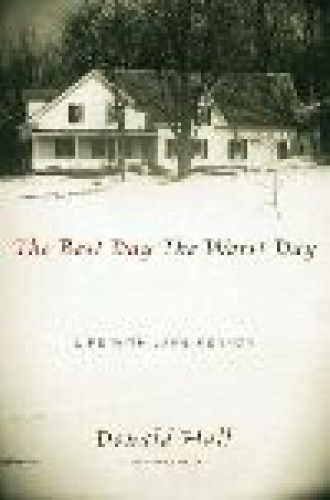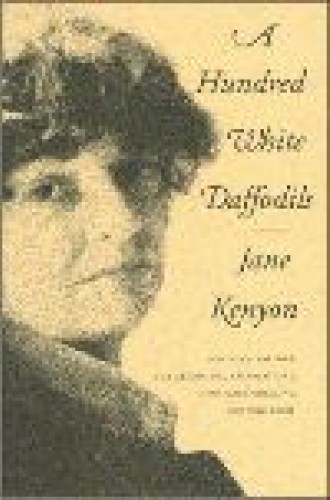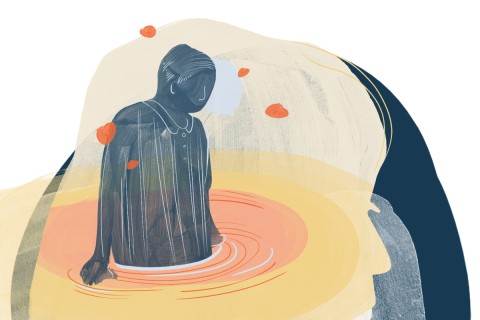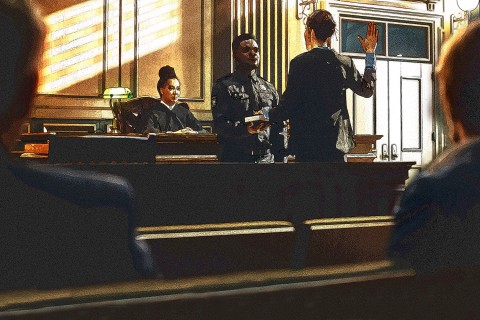Darkness and light
Edgar Allan Poe once famously opined that the death of a beautiful woman is “unquestionably the most poetical topic in the world.” What if the woman is also a poet, death comes early, and her husband is a famous poet as well? This convergence surely played some part in the renown that has gathered around Jane Kenyon. Yet even before her untimely death in 1995 fame had begun to find her. An award-winning Bill Moyers documentary about Kenyon, her husband, Donald Hall, and their life together surely helped. And just as surely, none of it would have happened if not for her brilliant books of poems—The Boat of Quiet Hours (1986), Let Evening Come (1990), Constance (1993) and the posthumous Otherwise (1996). A clutch of recent books, including a generous collection of poems from Graywolf, her longtime publisher, seem sure to keep both her work and her life in the public eye.
Kenyon’s life story is fascinating and wrenching, the stuff of both highbrow and middlebrow drama. She was a college student who married her much older professor, retreated with him from university life to a family farmhouse in New Hampshire, rediscovered her faith (without turning into a wild-eyed zealot), bravely battled depression, came into her own as a poet and loyally nursed her husband through two difficult bouts with cancer. Just when all seemed to be looking up, she was herself struck down by leukemia, leaving behind a legacy of unsparing, brave and beautiful poems.
Squinted at in another way, Kenyon’s life follows the arc of the classic conversion narrative: early churchgoing, adolescent rebellion, and return to the church as an adult. As she tells it, it was her grandmother’s “spiritual obsession” and frightening talk of hell that drove her away from the church as a girl: “By the time I was in high school I grew contemptuous of religion and the people I knew who practiced it, although I took great pains to hide this development from Grandmother. . . . I announced to my parents that one could not be a Christian and an intellectual, and that I would no longer attend church.”
Kenyon went to the University of Michigan, where she first encountered Hall in 1969 when she took his large, lecture-style poetry class. As Hall tells the story in The Best Day the Worst Day, they did not really meet until the next year, when she enrolled in his writing workshop. When they married in 1972, she was 24 and he 43.
Three years later she and Hall moved to his grandmother’s house in New Hampshire for what they thought would be only a sabbatical year. Their first weekend Hall mentioned that they would probably be expected to show up at the local church. An oft-repeated anecdote concerns the sermon they heard that first Sunday, and minister Jack Jensen’s mention of the German poet Rainer Maria Rilke.
“And how I did perk up then,” Kenyon remarks in an unfinished essay reprinted in A Hundred White Daffodils, which also includes interviews, columns written for a local newspaper and Kenyon’s translations of others’ works. “Even in the years of my apostasy I never doubted that God exists, and that I exist in relation to God.” At first their churchgoing was more social than spiritual, but before long they were regulars—Kenyon was church treasurer for more than a decade. “Within a short time,” she notes in an interview with Moyers, “I discovered that I had an enormous spiritual hunger that I knew nothing about.”
Before that first year was up, both were ready to remain in New England. The beauty of the area around Mt. Kearsarge and Eagle Pond, for which their house is named, was one factor. In an interview with Mike Pride, Kenyon explains deeper reasons: “I never felt a sense of community in Ann Arbor. Here I felt it immediately. . . . It makes one less self-obsessed and more concerned about the needs of others. It gives you a feeling that you are part of the great stream.”
Kenyon and Hall thrived in the unstructured days at Eagle Pond, and Kenyon in particular began to write more seriously and steadily than ever before. Solitude and “a lot of hours to fill” were crucial: “For me, poetry comes out of silence, and I can have silence here.”
Community and solitude, then, were two sides of the coin for Kenyon and Hall as they established their life together. Hall’s earlier books and other literary sources of income enabled them to avoid steady outside work and to devise a daily pattern that included large chunks of writing time. Hall describes their habits in The Best Day the Worst Day: “We got up early in the morning. I brought Jane coffee in bed. She walked the dog as I started writing, then climbed the stairs to work at her own desk on her own poems and on [poet] Akhmatova. We had lunch. We lay down together. We rose and worked at secondary things. I read aloud to Jane; we played scoreless ping-pong; we read the mail; we worked again. . . . If we were lucky the phone didn’t ring all day.”
Kenyon’s first book, From Room to Room (1978), is full of poems written after the move to New England. Some deal with her sense of dislocation and effort to feel at home: “You always belonged here. / You were theirs, certain as a rock. / I’m the one who worries / if I fit in with the furniture / and the landscape.” Kenyon’s signature style is present here, with its spare presentation, simplicity and details drawn from the natural world and domestic life. Poems like “Finding a Long Gray Hair” make it plain that the move will be successful in more ways than one: “. . . when I find a long gray hair / floating in the pail, / I feel my life added to theirs.” Beyond those details, though, she found a “subject” in the place itself: “The things I noticed about this place were all subjects for poems, and suddenly I had a broad view. . . . It’s still such an amazement that we live here among these mountains and hills.”
Early in the New England years, Kenyon began to translate the poems of Anna Akhmatova, the great Russian poet (1889-1966). This project, suggested to her by Robert Bly, energized her own writing: “I know that if I had not worked so hard on Akhmatova,” Kenyon remarked, “I would never have experienced that surge of power” that resulted in the poems in her second book, The Boat of Quiet Hours.
Jane Kenyon had a home in a beautiful place, freedom from day-to-day labor, a loving and successful spouse, friends, church, connections to a community, increasing success as a poet. Yet in spite of all these blessings, a ground note of darkness and suffering runs through her poems—one that tempers, complicates and finally enriches them. This note of melancholy is essential: “. . . the soul’s bliss / and suffering are bound together / like the grasses,” she wrote in “Twilight: After Haying.” Kenyon’s long struggle with bipolar disorder is inseparable from her work, as it was from the rest of her life. (She preferred the old-fashioned term melancholy.)
Hints of the existential darkness that was never too far from her can be seen even in her praise for the God her minister speaks of, “a God who overcomes you with love, not a God of rules and prohibitions. This was a God who, if you ask, forgives you no matter how far down in the well you are. If I didn’t believe that I couldn’t live.”
The other side of Kenyon’s movement to faith is implied in that last sentence. While her life and work were not defined by melancholy, they were surely saturated by it, drenched in it—and it is probably fair to say that her poems would not exist as we have them without melancholy. Their strength and beauty are found precisely in their honest grappling with despair and faith, and in the sense that the struggle between the two is perilously close.
Kenyon’s most difficult bout of depression came in 1982, following her father’s death. Many poems in The Boat of Quiet Hours (1986) are from this time. Some of the markers are explicit, as in “Depression in Winter” and “Ice Storm” (“The most painful longing comes over me. / A longing not of the body”). The yearning and sadness are not conquered so much as modulated into something slightly, subtly different—as in “Twilight: After Haying,” where bliss joins suffering as part of the soul’s reality, and both seem present in the beautiful, difficult praise of the world with which the poem ends:
The last, sweet exhalations
of timothy and vetch
go out with the song of the bird;
the ravaged field
grows wet with dew.
Such resolutions, however beautiful, were not final for Kenyon, and she would continue to work and live within these complications. Medication was of some help, as was the support of family and friends, but she endured the ups and downs familiar to anyone who knows bipolar disorder, and she was never entirely rid of them. “August Rain, after Haying” describes the feelings this way:
The grass resolves to grow again,
receiving the rain to that end,
but my disordered soul thirsts
after something it cannot name.
“Having It Out with Melancholy,” published in Constance (1993), offers Kenyon’s most extended description of her long struggle. Its epigraph from Chekhov is difficult and accurate: “If many remedies are prescribed for an illness, you may be sure that the illness has no cure.” Addressing the condition directly, Kenyon complains: “You taught me to exist without gratitude. / You ruined my manners toward God.” In part three, a “Suggestion from a Friend” is offered without comment: “You wouldn’t be so depressed / if you really believed in God.” That poem also describes a 1980 mystical experience: “I saw / that I was a speck of light in the great / river of light that undulates through time.” Yet the poem’s aim is not ecstasy but something much more modest: to “come back to marriage and friends,” even “With the wonder / and bitterness of someone pardoned / for a crime she did not commit”; to find it possible to rediscover “ordinary contentment” and ordinary life.
Perhaps kenyon’s most troubling major poem is “Women, Why Are You Weeping”—a late, long poem about a trip to India and its challenge to her faith. There is no easy recovery here, no recovery at all, only a new and unsettling series of images and questions:
India, with her ceaseless
bells and fire; her crows calling stridently
all night; India with her sandalwood
smoke, and graceful gods, many-headed and many-
armed, has taken away the one who blessed
and kept me.
Kenyon chose not to include this poem in Otherwise (1996), which was mostly written before her final illness but was assembled for publication during her treatment for leukemia. Hall, after consulting with their poet friends, decided to include the poem in both A Hundred White Daffodils and Collected Poems. Kenyon’s readers may be of various minds about this decision, but the poem, after sharp depictions of a series of street scenes, ends with a compelling image:
“What shall we do about this?” I asked
my God, who even then was leaving me. The reply
was scorching wind, lapping of water, pull
of the black oarsmen on the oars . . .
Whatever her doubts and griefs, something in Kenyon persevered in hope. Despite all the nearly unendurable elements of her life, she told Bill Moyers, “I feel that there is a great goodness. Why, when there could have been nothing, is there something? This is a great mystery. How, when there could have been nothing, does it happen that there is love, kindness, beauty?”
In the end, faith and poetry were not separable for Kenyon. Indeed, for her poetry was not merely an expression of faith but a means toward faith. “Poetry has an unearthly ability to turn suffering into beauty,” she once remarked, going on to relate her work to Emily Dickinson’s: “[She] thinks a lot about her soul, and I think a lot about mine. She thinks about her relation to God—a God who is distant, and rather clumsily arbitrary. In many of my poems I am searching, clumsily, for God. We are both full of terror, finally, and puzzlement, at the creation.”
Both poets’ search for God led them to create poetic landscapes that are highly charged, often lovely, sometimes frightening. Like Dickinson, Kenyon was convinced that her duty as a poet—and as a Christian, I think she would have added—was to honor the beauty, terror and mystery of existence.
“The poet’s job is to tell the whole truth and nothing but the truth,” she wrote, “in such a beautiful way that people cannot live without it; to put into words those feelings we all have that are so deep, so important, and yet so difficult to name.” The link between beauty and sadness is everywhere in her work, especially in her awareness of mutability. Perhaps her best poems are treasured by so many readers because of the way they poise between sadness and joy:
Things: simply lasting, then
failing to last: water, a blue heron’s
eye, and the light passing
between them: into light all things
must fall, glad at last to have fallen.







